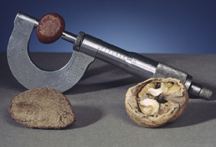Module 6 Summary
| Site: | MoodleHUB.ca 🍁 |
| Course: | Math 30-3 SS |
| Book: | Module 6 Summary |
| Printed by: | Guest user |
| Date: | Tuesday, 4 November 2025, 2:40 AM |
Description
Created by IMSreader
1. Module 6 Summary
Module 6 Summary

Wavebreak Media/Thinkstock
Measurement has many applications in everyday life. Developing a good understanding of the different measuring tools, including their degree of accuracy, precision, and tolerances can prevent unnecessary costs in time and materials to ensure that projects are measured properly the first time. This is really important for anyone in a trade who is making functional items that piece together.
Below are some of the key ideas you learned in each lesson.
In Lesson 1 you learned about accuracy and precision.
Accuracy is how close the measurement comes to the actual or true measure of the object.
Precision is determined by the smallest unit to which a tool can measure. |
iStockphoto/Thinkstock |
|
In Lesson 2 you learned about uncertainty.
Uncertainty is the margin of error in a measurement. |
Jupiterimages/Comstock/Thinkstock |
|
In Lesson 3 you learned about tolerance.
Tolerance is the variation in measurement that is acceptable. |
Creatas/Thinkstock |
|
In Lesson 4 you explored the application of precision, accuracy, uncertainty, and tolerance to measurements used in a vehicle. |
iStockphoto/Thinkstock |



